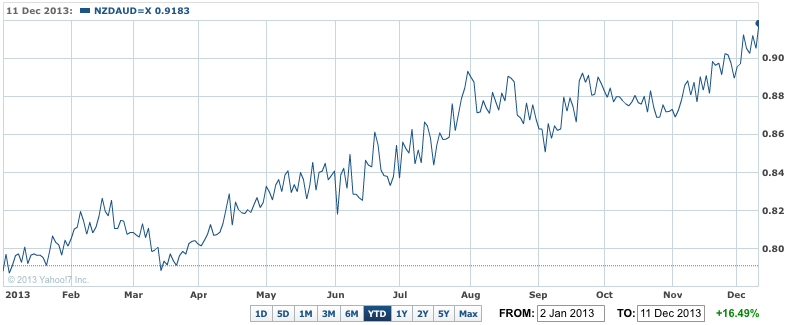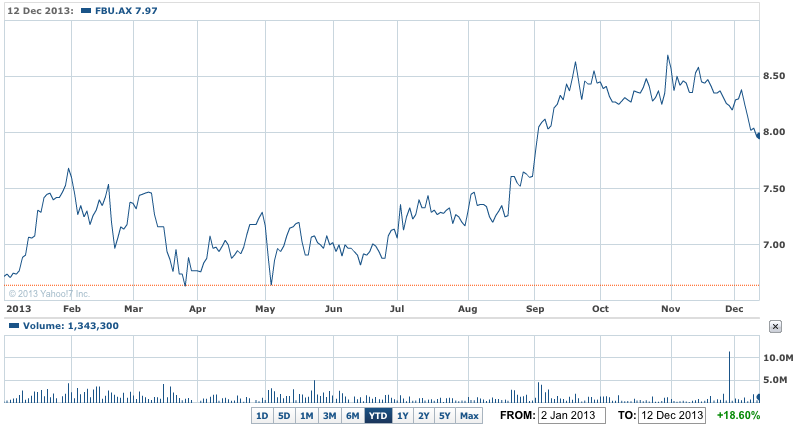The New Zealand economy is going to boom in 2014 and into 2015 thanks to a combination of a 40-year high for the country’s terms of trade and the spreading building boom in Christchurch, Auckland and now Wellington.
The economy is growing around 3%, according to estimates yesterday from the country’s Reserve Bank, and the outlook is very positive – in contrast to the spreading gloom in Australia.
That 3% growth rate is forecast to continue through all of 2014 before easing in early 2015, according to the Reserve Bank’s latest forecasts.
So it’s no wonder that Kiwis are starting to return to their homeland from places like Australia where job prospects are weakening.
A series of data releases and reports from government, industry and companies like the dairy giant, Fonterra, confirm that NZ will experience superior growth and employment than Australia is expecting in 2014.
Yesterday the RBNZ left its key interest rate steady on 2.5%, and gave no hint of the timing of the next move, apart from the now usual mention of inflation.
That, plus some suggestion of concerns about the strength of demand from the RBNZ, saw the Kiwi dollar continue its gains against the Aussie dollar.
In fact the Aussie hit a five year low yesterday of around $NZ1.095 after the RBNZ statement.
And there is a small but growing chance that the Kiwi dollar could reach parity with the Aussie currency in 2014 – roughly it’s trading around 83 US cents, up from 77 US cents in July.
With the Aussie dollar is around 90.50 US cents, the Kiwi is not too far away from parity.
NZDAUD YTD – A good year for the Kiwi dollar

And if that happened NZ would share in the pain that Australia has been ‘enjoying’ since the dollar reached and topped parity with the US currency over two years ago.
But seeing inflation is running at an annual 1.4%, well below the RBNZ’s 2% target, a rate rise seems a way off.
But there was a hint in the accompanying final Monetary Policy Statement of 2013 that a rate rise is out there, somewhere in 2014.
"The economy continues to strengthen. Looking ahead, demand will be boosted by high export commodity prices, low interest rates, momentum in the housing market, and continued reconstruction in Canterbury.
"Fiscal consolidation and the high New Zealand dollar are providing some offset. Given this outlook, it is becoming unnecessary to maintain the current degree of monetary stimulus," the RBNZ said.
"Export commodity prices remain very high, and dairy production has rebounded strongly since the drought. Low interest rates are providing further support to domestic demand. However, fiscal consolidation and the high exchange rate continue to weigh on activity."
That’s a much more confident picture than what we are reading and seeing in Australia, but its one with the suggestion that rates will start rising in 2014.
"The extent and timing of such pressures will depend largely on movements in the exchange rate, changes in commodity prices, and the degree to which momentum in the housing market and construction activity spills over into broader cost and price pressures," RBNZ Governor, Graham Wheeler said in yesterday’s statement.
But the stronger Kiwi dollar will impact returns to Australian companies, such as banks, retailers (Woolworths, Bunnings), media companies (Fairfax and APN), oil companies (Caltex Australia) and insurers and fund managers (AMP, AAMI/Suncorp).
Some companies could do well, others might be damaged. One way of monitoring the impact is to look at what some of these companies with big operations in NZ say in their interim profit statements next February and March.
Perhaps the best placed company that’s well known to Australian investors is Fletcher Building (FBU) which is the largest building products company in Australasia, especially in NZ.
Fletcher told its AGM in October that it is looking for a significant profit boost from increased building activity in NZ in the coming year, but didn’t expect much impact from Australia.
As we have seen in Australia in the past two years, the continuing rise in the value of the NZ dollar is pressuring the terms of trade, cutting export prices (despite record prices for dairy products on world markets). The falls in the prices of key imports, such as oil and petrol haven’t been able to offset the falls in export prices.
Export prices fell 6.3% in the quarter, led by dairy prices (down 13%), while import prices fell 3.3%, driven by fall a 13% drop in the prices of petroleum and petroleum products.
But the rising value of the dollar is helping pit a lid on inflation – as we also have seen in Australia.
The sharp fall in petroleum import prices is evidence of that positive side of a higher currency.
At the same time the government is keeping a tight hold on spending, and the RBNZ is watching the developing building boom like a hawk, especially the Auckland home shortage, and had already moved to try and slow the boom in home lending and prices.
The impact of the dollar and other factors saw Fonterra, the world’s largest dairy exporter, this week more than halve its dividend, while maintaining a record high milk price.
The New Zealand dairy cooperative cut its forecast dividend from 32 NZ cents to 10 NZ cents. Payouts for farmers will stay at $NZ8.30 per kg for milk solids for the current season.
Fonterra says the strong price of milk is being driven by demand from China, other emerging countries in Asia and North Africa. However, economic factors in Europe, the United States and Japan had meant cheese prices had not kept pace with milk.
The global dairy boom is the most important external factor for the NZ economy to grapple with – internally it’s the biggest property and construction boom for decades.
But to make sure that’s not hurt by the attempt to control home lending, the Reserve Bank this week exempted bank loans for new home construction from its tough new rules limiting the amount of money that can be lent for homes via loans with a high loan to valuation ratio (small deposits, lots of debt).
The central bank said the home lending with a high loan to valuation ratio accounts for 12% of all residential building activity. The central bank said the "exemption will help to support the supply of new housing and, in doing so, reduce some of the pressure arising from excess demand in the New Zealand housing market."
And the importance of trying to relieve some of that pressure in the building sector can’t be underestimated.
According to a report this week the unprecedented construction boom, stronger than anything seen in the past 40 years, is gathering strength.
Building and construction is tipped to grow by at least 10% a year in the next few years, peaking in 2016 when almost $NZ32 billion (more than $A29 billion) of activity is forecast.
The National Construction Pipeline report, commissioned by the Building and Construction Productivity Partnership, says the whole country will experience a surge in activity in both residential and non-residential sectors.
Construction hot spots are in Auckland, followed by the Canterbury (Christchurch rebuild) and then Waikato/ Bay of Plenty and Wellington.
The main drivers of growth are Auckland’s residential housing demand more than doubling (projected 150%) and the Canterbury rebuild, which is now forecast to cost $NZ40 billion on its own (up from an earlier estimate of $NZ30 billion).
FBU YTD – Fletcher building sees NZ solid, Australia weak

This is the sort of economy-wide building boom the Reserve Bank is searching for in Australia to replace the declining impact of the resources investment boom.
Unlike Australia, though, the Kiwi looks like it will enjoy a combination of solid exports and domestic growth from building and construction, without too much competition for resources, as we have seen in Australia where five years and more of a resources investment boom has seen housing and construction restrained.
But for Australian companies invested in NZ, the high value of the Kiwi currency will be a major influence on how well they do across the ‘ditch’













